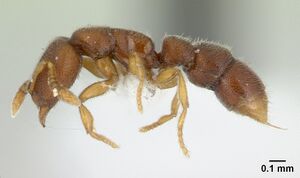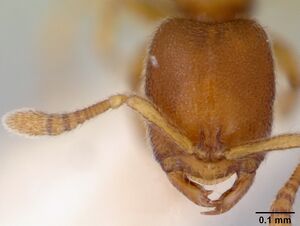Prionopelta opaca
| Prionopelta opaca | |
|---|---|

| |
| Scientific classification | |
| Kingdom: | Animalia |
| Phylum: | Arthropoda |
| Class: | Insecta |
| Order: | Hymenoptera |
| Family: | Formicidae |
| Subfamily: | Amblyoponinae |
| Tribe: | Amblyoponini |
| Genus: | Prionopelta |
| Species: | P. opaca |
| Binomial name | |
| Prionopelta opaca Emery, 1897 | |
| Synonyms | |
| |
This species has been found in rainforests with workers being collected from leaf litter on the forest floor. Nests occur in soil under objects and in rotten wood. P. opaca and Prionopelta robynmae have been collected from the same litter sample in PNG. (Shattuck 2008)
Identification
Shattuck (2008) - Anterolateral corners of head, near mandibular insertions, rounded. Dorsal mesosomal sculpturing composed of foveae which are only slightly more dense on the pronotum than on the mesonotum and propodeum, and which are uniformly distributed across the width of the propodeum. Body small, head width less than 0.48mm but petiole relatively broad, PetW greater than 0.21mm.
Keys including this Species
Distribution
Latitudinal Distribution Pattern
Latitudinal Range: 7.39° to -37.232674°.
| North Temperate |
North Subtropical |
Tropical | South Subtropical |
South Temperate |
- Source: AntMaps
Distribution based on Regional Taxon Lists
Indo-Australian Region: Micronesia (Federated States of), New Guinea, Palau, Solomon Islands.
Distribution based on AntMaps
Distribution based on AntWeb specimens
Check data from AntWeb
Countries Occupied
| Number of countries occupied by this species based on AntWiki Regional Taxon Lists. In general, fewer countries occupied indicates a narrower range, while more countries indicates a more widespread species. |

|
Estimated Abundance
| Relative abundance based on number of AntMaps records per species (this species within the purple bar). Fewer records (to the left) indicates a less abundant/encountered species while more records (to the right) indicates more abundant/encountered species. |

|
Biology
Castes
Worker
Images from AntWeb
   
| |
| Worker. Specimen code casent0173563. Photographer April Nobile, uploaded by California Academy of Sciences. | Owned by BNM, Koror, Palau. |
   
| |
| Worker. Specimen code casent0434875. Photographer Erin Prado, uploaded by California Academy of Sciences. | Owned by CAS, San Francisco, CA, USA. |
  
| |
| Worker. Specimen code casent0172298. Photographer April Nobile, uploaded by California Academy of Sciences. | Owned by ANIC, Canberra, Australia. |
Queen
Images from AntWeb
   
| |
| Queen (alate/dealate). Specimen code casent0434884. Photographer Erin Prado, uploaded by California Academy of Sciences. | Owned by CAS, San Francisco, CA, USA. |
Nomenclature
The following information is derived from Barry Bolton's Online Catalogue of the Ants of the World.
- opaca. Prionopelta opaca Emery, 1897c: 596, pl. 15, figs. 44, 45 (w.q.m.) NEW GUINEA (Papua New Guinea).
- Type-material: syntype workers, syntype queens, syntype males (numbers not stated).
- Type-locality: Papua New Guinea: (no further data) (L. Biró).
- Type-depositories: HNHM, MHNG, MSNG.
- Wheeler, G.C. & Wheeler, J. 1964b: 447 (l.).
- Status as species: Emery, 1911d: 33; Chapman & Capco, 1951: 26; Wilson, 1958a: 149; Brown, 1960a: 178, 220; Taylor, 1976a: 78; Taylor & Brown, 1985: 39; Taylor, 1987a: 64; Bolton, 1995b: 365; Clouse, 2007b: 260; Shattuck, 2008b: 29 (redescription); Sarnat, et al. 2013: 69.
- Senior synonym of mocsaryi: Brown, in Wilson, 1958a: 149; Brown, 1960a: 178, 216; Bolton, 1995b: 365; Shattuck, 2008b: 29.
- Distribution: Micronesia, Palau, Papua New Guinea, Solomon Is.
- mocsaryi. Prionopelta mocsaryi Forel, 1907a: 1 (w.) PARAGUAY.
- Type-material: holotype worker.
- Type-locality: Paraguay: Asuncion (Anisits).
- Type-depository: HNHM.
- [Misspelled as moczaryi by Emery, 1911d: 33.]
- Status as species: Forel, 1909a: 242 (in key); Emery, 1911d: 33.
- Junior synonym of opaca: Brown, in Wilson, 1958a: 149; Brown, 1960a: 178, 216; Bolton, 1995b: 365; Shattuck, 2008b: 29.
Unless otherwise noted the text for the remainder of this section is reported from the publication that includes the original description.
Description
Worker
Shattuck (2008) - (n=12) CI 76–80; HL 0.47–0.52; HW 0.37–0.41; ML 0.54–0.62; PetL 0.16–0.20; PetW 0.21–0.24; PI 110–136; SI 65–70; SL 0.24–0.27; T1W 0.31–0.36.
Anterolateral corners of head, near mandibular insertions, rounded and lacking a tooth. Dorsal pronotal sculpturing consisting of foveae which are only slightly more dense than on the mesonotum and propodeum. Foveae on dorsum of propodeum uniformly distributed across its width. Lateral mesosomal sculpturing consisting of small foveae on pronotum and anterior region of mesopleuron, ventral regions of mesopleuron and propodeum weakly striate, posterodorsal region of mesopleuron and majority of propodeum smooth. Fenestra present but weakly developed within subpetiolar process. Colour yellow-red to red-brown.
Type Material
- Prionopelta opaca: Syntype, workers(s), queen(s), male(s), Papua New Guinea, Museo Civico di Storia Naturale, Genoa.
- Prionopelta moscaryi: Syntype, worker, reported from Paraguay but probably in error for a SE Asian locality, Southeast Asia, Musee d'Histoire Naturelle Genève.
References
- Emery, C. 1897c. Formicidarum species novae vel minus cognitae in collectione Musaei Nationalis Hungarici quas in Nova-Guinea, colonia germanica, collegit L. Biró. Természetr. Füz. 20: 571-599. (page 596, pl. 15, figs. 44, 45 worker, queen, male described)
- Radchenko, A.G., Fisher, B.L., Esteves, F.A., Martynova, E.V., Bazhenova, T.N., Lasarenko, S.N. 2023. Ant type specimens (Hymenoptera, Formicidae) in the collection of Volodymyr Opanasovych Karawajew. Communication 1. Dorylinae, Poneromorpha and Pseudomyrmecinae. Zootaxa, 5244(1), 1–32 (doi:10.11646/zootaxa.5244.1.1).
- Shattuck, S.O. 2008b. Revision of the ant genus Prionopelta in the Indo-Pacific region. Zootaxa 1846:21-34.
- Wang, W.Y., Soh, E.J.Y., Yong, G.W.J., Wong, M.K.L., Benoit Guénard, Economo, E.P., Yamane, S. 2022. Remarkable diversity in a little red dot: a comprehensive checklist of known ant species in Singapore (Hymenoptera: Formicidae) with notes on ecology and taxonomy. Asian Myrmecology 15: e015006 (doi:10.20362/am.015006).
- Wheeler, G. C.; Wheeler, J. 1964b. The ant larvae of the subfamily Ponerinae: supplement. Ann. Entomol. Soc. Am. 57: 443-462 (page 447, larva described)
- Wilson, E. O. 1958c. Studies on the ant fauna of Melanesia. I. The tribe Leptogenyini. II. The tribes Amblyoponini and Platythyreini. Bulletin of the Museum of Comparative Zoology 118:101-153. (page 149, Senior synonym of mocsaryi)
References based on Global Ant Biodiversity Informatics
- Brown W. L., Jr. 1960. Contributions toward a reclassification of the Formicidae. III. Tribe Amblyoponini (Hymenoptera). Bulletin of the Museum of Comparative Zoology 122: 143-230.
- CSIRO Collection
- Clouse R. M. 2007. The ants of Micronesia (Hymenoptera: Formicidae). Micronesica. 39: 171-295.
- Clouse, R.M. 2007. The ants of Micronesia (Hymenoptera: Formicidae), Micronesica 39(2): 171-295.
- Emery C. 1897. Formicidarum species novae vel minus cognitae in collectione Musaei Nationalis Hungarici quas in Nova-Guinea, colonia germanica, collegit L. Biró. Természetrajzi Füzetek 20: 571-599.
- Emery C. 1911. Hymenoptera. Fam. Formicidae. Subfam. Ponerinae. Genera Insectorum 118: 1-125.
- Field Museum Collection, Chicago, Illinois (C. Moreau)
- Janda M., G. D. Alpert, M. L. Borowiec, E. P. Economo, P. Klimes, E. Sarnat, and S. O. Shattuck. 2011. Cheklist of ants described and recorded from New Guinea and associated islands. Available on http://www.newguineants.org/. Accessed on 24th Feb. 2011.
- Sagata, K., A.L. Mack, D.D. Wright and P.J. Lester. 2010. The influence of nest avaiability on the abundance and diversity of twig-dwelling ants in a Papua New Guinea forest. Insectes Sociaux 57:333-341
- Shattuck, S. O. 2008. Revision of the ant genus Prionopelta (Hymenoptera: Formicidae) in the Indo-Pacific region. Zootaxa 1846:21-34.
- Snelling R. R. 1998. Insect Part 1: The social Hymenoptera. In Mack A. L. (Ed.) A Biological Assessment of the Lakekamu Basin, Papua New Guinea, RAP 9. 189 ppages
- Snelling R. R. 2000. Ants of the Wapoga river area, Irian Jaya, Indonesia. In Mack, Andrew L. and Leeanne E. Alonso (eds.). 2000. A Biological Assessment of the Wapoga River Area of Northwestern Irian Jaya, Indonesia. RAP Bulletin of Biological Assessment 14, Conservation International, Washington, DC.
- Taylor R. W. 1976. The ants of Rennell and Bellona Islands. Natural History of Rennell Island, British Solomon Islands 7: 73-90.
- Taylor R. W. 1987. A checklist of the ants of Australia, New Caledonia and New Zealand (Hymenoptera: Formicidae). CSIRO (Commonwealth Scientific and Industrial Research Organization) Division of Entomology Report 41: 1-92.
- Taylor R. W., and D. R. Brown. 1985. Formicoidea. Zoological Catalogue of Australia 2: 1-149.
- Viehmeyer H. 1912. Ameisen aus Deutsch Neuguinea gesammelt von Dr. O. Schlaginhaufen. Nebst einem Verzeichnisse der papuanischen Arten. Abhandlungen und Berichte des Königlichen Zoologischen und Anthropologische-Ethnographischen Museums zu Dresden 14: 1-26.
- Wilson E. O. 1958. Studies on the ant fauna of Melanesia. I. The tribe Leptogenyini. II. The tribes Amblyoponini and Platythyreini. Bulletin of the Museum of Comparative Zoology 118: 101-153.
- Wilson Edward O. 1959. Adaptive Shift and Dispersal in a Tropical Ant Fauna. Evolution 13(1): 122-144

